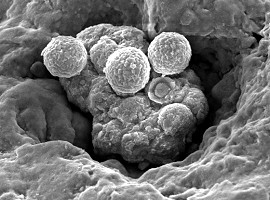|
 Dry Desert Varnish up close and personal showing recently living colony. (Scanning Electron Micro- scope image by M. Spilde). |
As field scientists, we know that even on Earth the search for biosignatures of present life and indicators of past life depends upon recognition of structures, textures, and other data sets at widely varying spatial scales. In this sense, life detection for Mars is a classical field science investigation.
We will conduct a field campaign that couples detection and study of desert geomicrobiological biomarkers and mineralogical features at a variety of both vertical and spatial scales. Novel technologies required to accomplish this include an aerial imaging platform, a ground-based in situ chemical detector (The Rocktaster), and a novel, low resistive force drill.
Human investigators, acting as surrogates for surface robotic systems, perform some in situ experimentation and some sample collection. Collected samples will be further analyzed in the laboratory to assess the reliability of various techniques for predicting and detecting desert biomarkers. Our goal is to develop the operational search strategies at a series of spatial scales that will maximize life detection mission success and can be modified for future robotic Mars missions.
On Earth, desert surface and subsurface systems are tied together by hydrology but of a subtle variety unlike that of high precipitation environments. Recent dramatic findings about the potential hydrological cycle of the desert planet Mars include the detection of relatively young, apparent ground-ice sapping features, very recent detection of near-surface hydrogen that may indicate water ice, and Mars Odyssey data showing that the Martian rock layers have a complicated geological history which may involve hydrological processing. Together these findings strengthen the case for Mars as a desert world with a still active hydrological cycle of some variety. They also strengthen the possibilities for finding near subsurface life in zones where ground ice may meet above-freezing temperatures.
Our primary operational objective is to combine a selection of enabling technologies with a set of real science goals in a Mars analog desert site to develop a meaningful search and detection strategy for automation and application to future missions.
Our main scientific objective is to reliably identify and characterize surface processes that have microbial significance and may also reflect related subsurface processes (e.g. in caves, voids, aquifers, and shallow subsoils). In particular, manganese and iron oxide desert rinds, tafonated sandstone microhabitats, and surface evaporates (including carbonates) are potentially relevant to Mars. We are actively studying related materials in arid land caves and surfaces as part of our on-going extreme environment research.
Return to the Martian Caves Index
Copyright © 2002-04 - Complex Systems Research; Inc.
